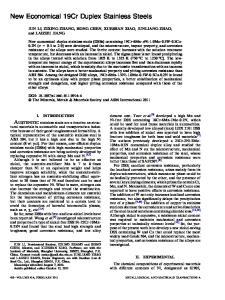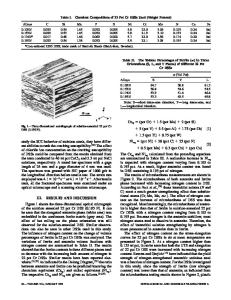Impact Toughness of Isothermally Treated Duplex Stainless Steels
- PDF / 894,325 Bytes
- 7 Pages / 612 x 792 pts (letter) Page_size
- 81 Downloads / 340 Views
Impact Toughness of Isothermally Treated Duplex Stainless Steels I. Calliari1, M. Breda1, G. Straffelini2, A. F. Miranda Perez3, F. A. Reyes Valdes3 1
2
Industrial Engineering Department, via Marzolo 9 int.4, Padova, Italy. Department of Materials Engineering and Industrial Technologies, Mesiano 77, Trento, Italy. 3 Corporación Mexicana de Investigación en Materiales, Ciencia y Tecnologia 790, Saltillo, México. Email: [email protected]
ABSTRACT Duplex stainless steels (DSS) have good mechanical and corrosion resistance properties which allow their application in very aggressive environments. However, their aging at 600– 1000 °C causes the precipitation of dangerous intermetallic phases, resulting in serious detrimental effects on their interesting properties. These secondary phases are structural discontinuities which act as preferential cracks initiation sites and their negative effect is especially highlighted on toughness. For these reasons, many standards related to the manufacturing of DSS require the microstructure of these steels "free from intermetallics". In this paper, the effect of isothermal heat treatments on the impact toughness in two Duplex steels (SAF 2205 and Zeron®100) has been investigated, in order to study the influence of different amount of secondary phases on the toughness response.
Keywords: steel, toughness, corrosion, embrittlement, microstructure.
INTRODUCTION Duplex stainless steels (DSS) have a ferritic-austenitic microstructure which allows the combination of high mechanical and corrosion-resistance properties. Generally these steels have considerably higher yield strength than the austenitic grades and their enhanced resistance to pitting corrosion makes them suitable for structural applications in very aggressive environments. In DSS, the mechanical properties are modulated by the biphasic microstructure, allowing the achievement of the best features deriving by the peculiar properties of the different lattice structures of the present phases. The tensile properties are essentially governed by the ferritic matrix, while the good toughness is ascribed to the austenitic phase, which retards the cleavage fracture of ferrite [1]. However, the use of DSS is limited, owing to their susceptibility to the formation of intermetallic phases, such as σ- and χ-phase, which form after ageing the material in a temperature range over 600 °C [1–9]. The critical temperature ranges depend on composition and very fast precipitations can occur, also after 3–5 minutes of ageing treatment. Morphology and localization of the secondary phases are well known and already described [1– 8]. As already reported, the first precipitating phase is generally χ and, by increasing the ageing time, the σ-phase starts to appear in the form of coarser particles [10, 11]. The precipitates are structural discontinuities which worsen the mechanical properties by causing stress intensification in correspondence of them and thus becoming the preferential cracks initiation
sites. For this reason, after the pr
Data Loading...











